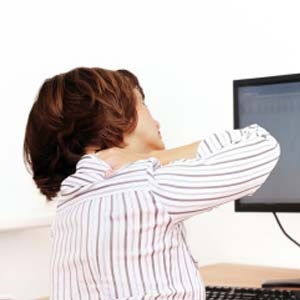
How many hours did you spend sitting today? Even if you have an active lifestyle, sitting down is how most of us spend a good part of our day. Between driving, working at the computer and watching TV, experts estimate that we spend in excess of nine hours in the seated position. The consequences? Backache, headaches and neck pain.
People in the office environment are especially at risk. A new study by the Division of Physiotherapy at Stellenbosch University reveals that academics are exposed to up to 12 hours of computer work a day and that computer-related musculoskeletal pain is on the rise. Neck pain prevalence is as high as 77% and low back pain is roughly 45% among academic workers. The study found that the strongest predictors of musculoskeletal related pain among office workers include the duration and frequency of computer work, little variation between academic tasks, job strain, female gender, poor ergonomic workstation design and comfort of computer workstation.
While workstation design is one key area that can be addressed, investigations into people’s sitting habits during workstation assessments have repeatedly shown that people do not sit in the ideal way. Yes, researchers have spent a great deal of time determining what the most healthy sitting positions are, but the recommended ‘sitting norms’ are unfortunately static, making it impossible for people to stick to them throughout the day.
Furthermore, according to one of Europe’s leading ergonomic experts, Malte Lenkeit of the Dauphin HumanDesign Group, although any healthy person could claim that they sit correctly, the fact is that no two people sit the same way. A recent study that looked at the way people used office chairs confirms this.
It showed that a person’s sitting habits are adopted during childhood as part of a formative process in much the same way that we learn to walk. Just as comfortable shoes play an important role in preventing fatigue when walking, a carefully adjusted chair plays an important role in ensuring employees have the freedom to sit in their own specific way.
Sitting safely
So what is the best way to sit? Experts all agree that a ‘dynamic seated posture’ is desirable as it prevents one-sided strain being placed on the muscles. A recent field study carried out by Dr Fritz Andreas Scion and Dr Dieter Preim from the RWTH Aachen shows that a dynamic seated posture requires both a specific degree of freedom and limits. They found that in addition to sweeping movements and changes in a seating position, which affect the strain on the spinal column, micro-movements play an important role too. If micro-movements are restricted, a balanced physical posture when sitting becomes impossible.
Another prerequisite for a balanced seated posture is a slight forward tilt of the pelvis, which takes the strain off it. Contrary to popular belief, the laid-back, slouched seat position is actually anatomically incorrect as it puts pressure on the spine. The ideal is a forward seat tilt of -12 (degrees) because this mimics the position of the pelvis when standing and minimizes strain on the spinal column.
The Division of Physiotherapy at Stellenbosch University conducted a study to determine the effectiveness of an individually-fitted ergonomic chair on low back pain, neck pain, muscle tension as well as chair comfort among academic staff.
The subject was a 51-year-old professor who had chronic neck and low back pain. He perceived his spinal symptoms to be related to computer usage. The chair was individually adjusted to the subject using standard ergonomic criteria for matching a chair to the individual’s anthropometry. The study was conducted over a period of seven weeks. It consisted of two phases – the baseline phase when the subject sat on his usual office chair and an intervention phase where the subject was required to use the ergonomic chair.
What the study found
The findings showed that the chair had a positive effect on all symptoms except for neck pain intensity. Low back pain intensity and frequency decreased, neck pain frequency decreased, neck muscle tension frequency and intensity decreased and chair comfort increased. Although this study was conducted on only one subject, the initial findings are important and demonstrate that further research in this area would be useful. Currently Rhodes University together with Dauphin are working on a project to demonstrate not only the health benefits to the user of ergonomically sound chairs but also to demonstrate the financial benefits that are gained through improved productivity.
‘Dynamic movement is key,’ says Debbie Arnoldi-Radford, MD of Dauphin HumanDesign Group (South Africa). Our bodies are better designed to be on the move, than to spend long periods of time in the same position. Movement is therefore a decisive factor in the fight against the typical complaints for seated employees.’
Establishing healthy habits
Arnoldi-Radford also points out that in addition to having the right chair, anyone can achieve noticeable improvement simply by changing certain habits at their desks.
Andrew Todd, Lecturer at Rhodes University Department of Human Kinetics and Ergonomics and chairman of the Ergonomics Society of South Africa (ESSA) agrees.
‘In addition to finding the right match between chair and desk and their own physical characteristics, workers should incorporate appropriate rest breaks. These breaks should be short and frequent and involve movement, for example alternating between sitting (60% of your day), standing (30%) and walking (10%) two to four times and hour. This will relieve the contraction of the back and neck muscles, stimulate activity in the extremities, the heart and improve blood circulation. As a rule, five minutes of active stretching and training of the back musculature each day is better than half an hour once a week.’
Ensuring comfort in the seated work environments requires two important factors to be adhered to. Firstly that the office environment is ergonomically sound, with compatibility between the anthropometric characteristics of the user and the office environment. However, the maintenance of a static posture (no matter how ergonomically sound) will ultimately lead to fatigue.
Consequently the inclusion of a chair that has adjustability as a key feature coupled with frequent changes in position is imperative for optimal workspace design. This will hopefully ensure not only that the user is more comfortable and healthy but also that they are more productive, thereby helping not only the individual but also the business they work for.
Visitors to the Dauphin HumanDesign® Group‘s Johannesburg and Cape Town showrooms can get the low down on their seating habits from the group’s two technologically advanced measuring tools – ErgoMouseand theEyeseat. Pioneered by their European parent company, the tools extract data relating to employee’s seating habits and help individuals make smart seating choices.
(Press release, Dauphin HumanDesign, September 2011)




 Publications
Publications
 Partners
Partners











